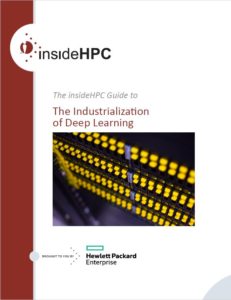This is the fifth article in a series taken from the insideHPC Guide to the Industrialization of Deep Learning.
Humans are very good at visual pattern recognition especially when it comes to facial features and graphic symbols and identifying a specific person or associating a specific symbol with an associated meaning. It is in these kinds of scenarios where deep learning systems excel. Clearly identifying each new person or symbol is more efficiently achieved by a training methodology than by needing to reprogram a conventional computer or explicitly update database entries.
A simple example is to accurately identify company logos, something that a human being should easily be capable of. The limitation for a human being is the number of logos to be recognized and the speed at which the logos are presented. A typical example might be a televised sports event where multiple sponsor logos are being displayed. A typical human being would struggle to keep up with even a small number of logos being displayed in real time, let alone thousands with any degree of precision and recall.
A computer-based system would clearly have a speed and capacity advantage over a human on a single video stream, and if the number of simultaneous video streams was increased to ten, twenty or a hundred then the problem would far exceed human capability. This kind of problem is well within the capability of current deep learning systems and it is also a straight forward process to add any number of new logos with an update to the training and test data sets.
If IBM has Watson then what does it take to be Sherlock?
IBM has done an excellent job promoting the capabilities of cognitive computing systems over the years, including the high profile matches between the Deep Blue system and chess world champion Gary Kasparov in 1996 and again in 1997. While the results of the matches became controversial, at best it appeared that man and machine were evenly matched. The next high profile public engagement came in 2011 when Watson competed and won against two former winners of the game show Jeopardy. Since that time Watson has played a central role in IBM’s cognitive computing strategy.
IBM Watson is a technology platform that uses natural language processing and machine learning to reveal insights from large amounts of unstructured data. As impressive as its results are in many real world applications it only addresses certain subsets of the cognitive assistance opportunity. Watson’s strengths lie primarily in language and text based learning and reasoning which are extremely important to many aspects of human life, but far from the ultimate range or potential of deep learning and artificial intelligence to human existence.
Another limitation of IBM Watson is the go to market model. Watson was developed on IBM’s proprietary POWER architecture, runs on a purpose built system, and is delivered as a service through the Bluemix cloud platform APIs. Currently there appears no way to actually buy or own a Watson, especially on Intel’s processor architecture. In Sir Arthur Conan Doyle’s classic detective stories Dr. Watson is primarily the chronicler, astute assistant and catalyst to the brilliant Sherlock Holmes, supporting but never able to match Sherlock’s deductive reasoning capabilities in the myriad scenarios faced by the intrepid if enigmatic detective.
For deep learning and artificial intelligence to move beyond the Conan Doyle Watson level to the seemingly unbounded inference capabilities of Sherlock Holmes, greater degrees of freedom are required. More control and choice over the nature and configuration of the underlying hardware infrastructure is necessary. More control, choice and flexibility over the software tools, especially access and participation in an open source environment will be needed to extend the capability and optimization potential hidden by closed and proprietary APIs.
Enabling the broad transformation that deep learning promises to bring to commercial enterprises requires enabling broad adoption that is easy to consume and control without restriction. It requires access to products and tools that are available to a global community, and are also easy to consume. This will include access to the latest technologies as vendor advances leapfrog one another, the use of open source tools to influence, adapt and optimize solutions across a vast landscape of disciplines, and the support of an industrial grade and global partner.
In coming weeks, this series will consist of articles that explore:
- Deep Learning and Getting There
- Technologies for Deep Learning
- Components for Deep Learning
- Software Framework for Deep Learning
- Examples of Deep Learning (this article)
- HPE Solutions for Deep Learning / HPE Cognitive Computing Toolkit
If you prefer you can download the complete inside HPC Guide to The Industrialization of Deep Learning courtesy of Hewlett Packard Enterprise






